At the heart of the pollination issue lies our bounty of foods such as peaches, strawberries, squash and apples. These and other foods requiring pollination have been staples in the human diet for centuries, and their pollinators have been highly revered since ancient times. From Egyptian hieroglyphics and Native American cave paintings to Greek mythology and English poetry, bees and butterflies have been a source of fascination and awe for millennia (Figure 1).
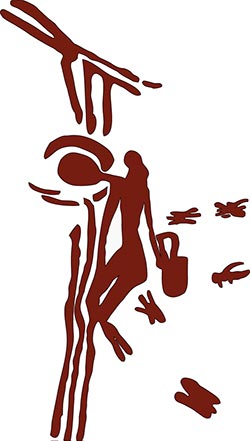
Figure 1. Ancient cave painting depicting honey harvesting.
Missouri Master Pollinator Steward program
This publication is one in a series that focuses on pollinators and how you can join the efforts to protect them. In addition to these publications, the Missouri Master Pollinator Steward program offers training that includes hands-on activities aimed at building awareness of key pollinators' plight and needs, and inspiring confidence in your ability to make a difference. Learn how you can become a Master Pollinator Steward.
Yet, over the past century, pollinator numbers have suffered declines. During this time, global development, a booming human population, and industrial agriculture brought about drastic landscape changes. These changes have resulted in greater losses of forage and nesting resources for pollinators than ever before seen. The ecosystem service of pollination, once taken for granted, is now potentially threatened as many pollinator species face declines in Missouri, the United States and many regions around the world.
Pollinators are critically important for natural ecosystems and crop production. Through pollination, they perform roles essential to human welfare. Heightened public awareness of their services and of their declines over the past two decades has prompted action, but much remains to be done.
This publication introduces issues regarding the conservation of pollinators in Missouri. It explores why pollinators are crucial, what major threats confront them, what conservation steps are being taken, and how you can help. It highlights bees over other pollinators as bees are the most important for both agricultural and natural pollination in Missouri.
Go to the bee, thou poet: consider her ways and be wise.
— George Bernard Shaw
The importance of pollinators
Environmentalists, farmers and scientists are working tirelessly to save species across the globe as human expansion encroaches on habitats. Some people readily see that these species have value as a part of biodiversity. Others see no compelling value in particular species or their relevance to society. Pollinators, however, have enormous value to society. Not only do they increase the productivity of Missouri’s farmland, they also play an important role in maintaining the health of our forests. In short, their conservation is an effort with which everyone should be concerned.
Pollinators in nature
One hundred fifty years ago, Charles Darwin proposed that one could predict the numbers of certain flowers in a neighborhood solely by knowing the number of cats. His hypothesis was surprisingly accurate: cats control the population of mice, which raid the nests of bumble bees, reducing their population. Bumble bees are critical for the pollination of certain flowers, so their decreased population changed the balance of flowers in the neighborhood. This story demonstrates the interactions that occur between species in nature (Figure 2). Hopefully, it also gives us a deeper understanding of the importance of pollinators in ecosystems and how upsetting an ecosystem can have unintended results for them and their host plants.
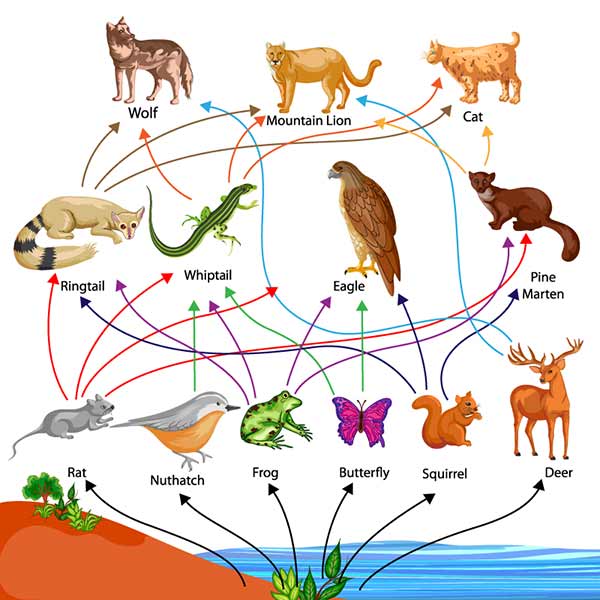
Figure 2. This sample food web shows how the plants and animals in a habitat are interconnected.
In ecology, the term “keystone species” is used to describe a species on which other species of the ecosystem depend, either directly or indirectly, and whose removal would prompt a dramatic change in an ecosystem. The wolf, for example, is a keystone species because it controls populations of herbivores (deer, elk, rabbit, etc.) that consume the various plants that in turn support numerous species, including birds and insects. The loss of a keystone species thus has effects at many levels in an ecosystem.
Pollinators are considered keystone species because they are responsible for the pollination of many important flowering plants. About 80 percent of the world’s 300,000 flowering plants require the help of animal pollinators to reproduce. (The remaining 20 percent either self-pollinate; are pollinated by wind, as with oak trees and corn; or are pollinated by water, as with many oceanic plants.) Bees are responsible for 67 percent of pollination services, making them by far the most important pollinator for natural ecosystems. Further, the results of their labor — seeds, nuts and fruits — are the primary source of nourishment for many birds, mammals and insects. For example, roughly 25 percent of birds in Missouri rely on the work of pollinators for their main food source, and the Missouri black bear derives a large portion of its diet from berries, which do not set good fruit without insect pollination. If fewer plants receive adequate pollination, less food will be available for animals. Like in the wolf scenario, these effects are felt throughout the ecosystem.
Pollinators are also considered indicator species. As such, their presence, abundance and health can provide insight into the health of an entire ecosystem. A diverse and healthy pollinator community will support a variety of plants and thus the rest of the environment. The decline in pollinators is alarming, not just because more species are being added to the threatened or endangered list, but because they are keystone species that play a vital role in natural ecosystems. The recent decline in numbers of the rusty patched bumble bee and monarch butterfly could, therefore, be indicative of overall habitat health in Missouri.
Pollinators in agriculture
Pollinators also play an important role in agriculture as they are responsible for the pollination of many of our food plants (Figure 3). Roughly 35 percent of our food depends on animal pollination for production. Thus, if you eat a balanced diet, roughly every third bite of food you take is thanks to the work of pollinators. These foods are primarily seeds, nuts, oils, spices, stimulants, fruits and vegetables, but also dairy and meat if animals are allowed to freely graze in pastures with forbs. Pollinators are also responsible for the pollination of many cover crops, which add fertility to soils when used in rotation with food crops.
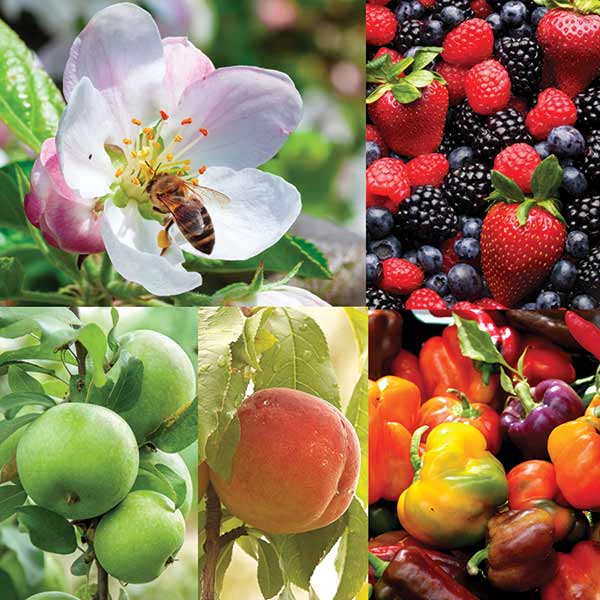
Figure 3. Many of our food plants require the help of animal pollinators, such as the honey bee, to reproduce.
Agricultural pollination is a huge industry with an annual economic value of $29 billion in the U.S. and $217 billion worldwide. Most of this pollination is done by managed bees, native bees or feral honey bees, or in most cases, a combination of the three. The principal species for pollination throughout history has been the honey bee (Apis mellifera) owing to its large colonies (some can have up to 100,000 bees), ease of movement, and relative effectiveness of pollination. Honey bees, which were originally brought to North America from Europe, are the primary contributors to the pollination of fruit and nut trees, berry brambles, squashes and many other food plants.
The welfare of the honey bee has declined drastically in the past two decades. Commercial and hobby beekeepers alike see 30 to 50 percent losses each year due to colony collapse disorder (CCD) or other maladies (Figure 4). The total number of hives in the U.S. has decreased by over 60 percent since the late 1990s. The exact causes of the decline are yet unknown, but consensus among authorities points to the combined effects of parasites and diseases, agrochemicals and degraded habitat. Nonetheless, the honey bee remains by far the most economically important and effective commercial pollinator for agricultural needs.
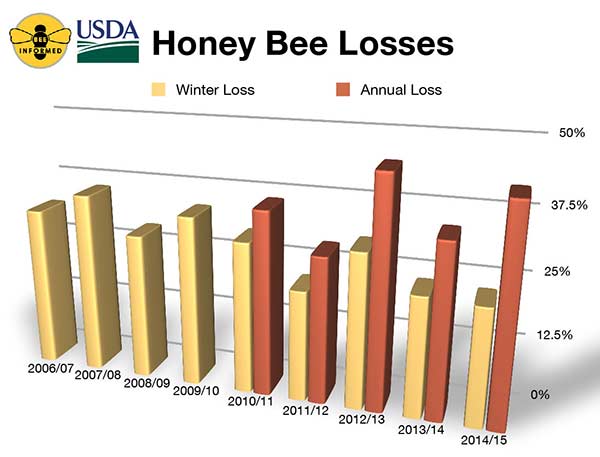
Figure 4. Annual loss of honey bee population in the U.S., 2005–2015.
Several other pollinator species have grown in importance over the past few decades. The alfalfa leafcutter bee (Megachile rotundata) is a solitary bee that is intensively managed for the pollination of alfalfa, canola and seed clover. Its pollination services on alfalfa have been shown to triple-seed set, making it invaluable for the dairy industry, which relies on alfalfa as a primary feed source for cattle. The blue orchard bee (Osmia lignaria) has been used commercially for the pollination of fruit and nut orchards. It is a more effective pollinator on many plants, with one female touted to provide as much pollination as more than 50 honey bees. It is often used with the honey bee, however, leading to better pollination services than either could provide alone. Several other mason bees (Osmia spp.) are also used for commercial fruit and nut pollination (Figure 5).
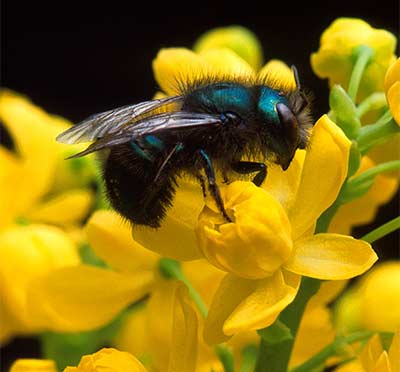
Figure 5. The mason bee Osmia ribifloris (shown on a barberry flower) is used commercially to pollinate blueberries.
Pollinators and the plants that need them
The degree to which plants are affected by pollinator loss varies. Many pollinators are generalists, foraging on and thus pollinating many different plants. To some degree, generalists are substitutable: If one is removed, its pollination services are provided by others. There are, however, specialist relationships in which certain plants have only one kind of pollinator and vice versa. These relationships are the most at risk because the decline of either the pollinator or the plant will cause the decline of the other.
Some plants are less dependent on pollinators than others. Many plants can self-pollinate, or clone themselves, if they do not receive animal pollination. Examples include peas, blackberries and mayapples. Specialist plants that are dependent on bees are more likely to be negatively affected in their absence than are generalists that are served by a variety of pollinators and can self-pollinate.
Various species of bumble bees have also been raised for pollination services. In the U.S., the primary species of use are Bombus occidentalis in the west and Bombus impatiens in the east. Bumble bees are important pollinators for tomatoes, eggplants, peppers and many varieties of berries. They are unique as pollinators in their ability to buzz pollinate, or sonicate. In this behavior, the bee presses its thorax against the base of the flower’s anthers and rapidly moves its flight muscles, causing a buzzing. The vibration causes pollen to eject from anthers, providing the bee with a source of protein and the plant with a greater chance of reproducing. Many plants, such as those in the nightshade family (for example, potatoes, tomatoes and peppers), do not offer nectar as a reward, and store their pollen in tubelike anthers where it is difficult for honey bees and others to access; the buzzing, or sonication, of bumble bees helps to release the pollen. The use of bumble bees to pollinate greenhouse tomatoes has been shown to significantly increase both the quantity and quality of the tomatoes produced (see MU Extension publication M404, Native Pollinators and Their Habitats, for more on this topic).
In addition to managed pollinators, native bees and feral honey bees play a vital role in agricultural pollination services. There are more than 4,000 species of native bees in the U.S., about 450 of which can be found in Missouri. Although they account for nearly $4 billion in annual production, they provide this ecosystem service at no direct cost to us. Many native bees are more effective at pollination than the honey bee. For example, the squash bee (Peponapis limitaris) removes and deposits four times as much pollen on squash plants than the honey bee does. In orchards, the presence of native bees together with honey bees has an additive effect on total pollination and fruit set that cannot be achieved by honey bees alone. Continually blooming wildflower edges and interspersed hedgerows will attract native bees and feral honey bees if a farm is located far from natural areas.
Pollinators play a crucial role in our food system, from pollinating the clover that fixes nitrogen into the soil to filling our orchards with bounties of fruits and nuts. Much of modern agriculture relies on these creatures for the production needed to meet high demands. And often, pollinators perform these services for free and without human involvement. For us to continue to have a rich array of foods at low cost, both wild and managed bees must be considered when planning or managing agricultural land.
Threats to pollinators
To most people, the phrase “threatened pollinators” conjures up only the honey bee and the monarch butterfly. Yet, species declines are apparent in many pollinator groups. The major causes of these declines fall into three groups: habitat destruction/degradation; exposure to pesticides and other agrochemicals; and pest, pathogen and disease spread.
Habitat destruction/degradation
The greatest problem pollinators face is habitat loss. The human population has increased dramatically over the past couple centuries, climbing from 1 billion in 1800 to 7.5 billion in 2017, and is estimated to reach 11 billion by 2100. To accommodate the needs of humans for food, materials and leisure spaces for that many people, we must shape the land to fit these demands. As a result, the landscape in the U.S. and worldwide is radically different than it was a few thousand years ago. These changes have had obvious and direct effects on the organisms that originally lived on Earth.
The largest pressure exerted on the land is for food. Nearly 40 percent of the land on Earth has been converted to agricultural production, and roughly half of the remaining land is desert. In Missouri and the entire U.S., most agricultural land is used for meat production. The northern half of Missouri historically hosted diverse tallgrass prairies, but a mere 1 percent of this pollinator-rich habitat remains. Instead, most of that land is planted in corn and soybean for animal feed purposes. The story is similar across the U.S. and in other parts of the world. For species that do not have expansive ranges or that have specialist relationships with other species, this pressure creates a very difficult situation.
What little natural habitat remains — in parks, national forests, conservation areas and the like — is starkly different from the natural habitat that existed throughout the organisms’ evolutionary history. The U.S. was logged, mined, hunted, fished and grazed extensively during the 19th and 20th centuries, before modern conservation practices were implemented. Add to the effects of these activities numerous invasive species, noise and light pollution (which can adversely affect insect communication and movement), and human traffic, and we are left with an ecosystem community with a very different composition than it had before. In the face of these pressures, it is little wonder pollinators are declining around the world.
In addition, much of the remaining habitat is sparse and highly fragmented. This situation makes it hard for species of all sorts, including migrating birds and butterflies, to find resources and move from one patch of habitat to the next. For example, a small solitary bee whose nest is along a brushy fence line may find the rows of crops between one fence line and the next impossible to cross. Much work is still needed to preserve habitat and to link existing natural areas so as to create a network of resources for wildlife through which they can easily move.
Pesticides
Rachel Carson’s 1967 book Silent Spring exposed for the first time the effect of chemicals on local ecosystems in the U.S. She argued that toxins intended to target a pest would likely build up in the tissues of other organisms in the environment and have unforeseen negative consequences. This result was well-documented; toxins had accumulated in insect-eating birds, reducing their ability to reproduce. Carson also argued that overuse of pesticides and herbicides merely favors disease-resistant individuals.
DDT, the primary pesticide Carson targeted in her book, was eventually banned due to concerns over environmental toxicity. In its place, however, came a plethora of chemical pesticides. These compounds target the nervous system of insects and are considered toxic to bees. The effects are different across species and depend upon concentration and avenues of exposure. Symptoms of sublethal doses in honey bees include wobbly flight, loss of flight, regurgitation of nectar, erratic egg-laying, impaired brood development, and queen loss. Most of these chemicals are no longer in use in the U.S., but many, including DDT, are still regularly used in other countries.
The most prevalent types of pesticide in the U.S. today are neonicotinoids, whose use has greatly increased in the past two decades (Figure 6). Called neonics for short, this family of pesticides — which includes imidacloprid, the most heavily used pesticide in the world — is chemically similar to the naturally occurring nicotine compound. Neonics are sold under a variety of brand names, including as common garden products in retail stores. They are systemic pesticides, which means they are present throughout the plant tissues, not just on the foliage. Their presence in the tissues prevents chewing insects such as caterpillars from feeding on leaves, but also harms nontarget species such as bees when they collect pollen and nectar from the flowers.
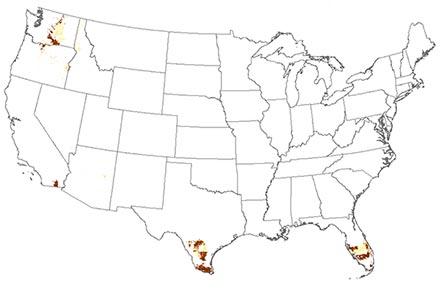
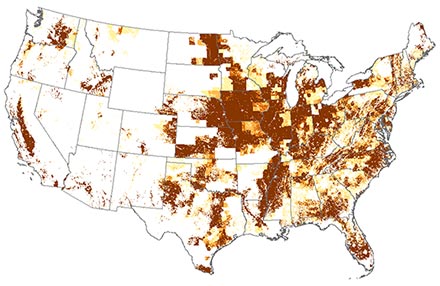
Estimated use on agricultural land, in pounds per square mile
![]() Less than 0.01
Less than 0.01 ![]() 0.01 to 0.02
0.01 to 0.02 ![]() 0.03 to 0.04
0.03 to 0.04 ![]() Greater than 0.04
Greater than 0.04 ![]() No estimated use
No estimated use
Figure 6. Estimated agricultural use of imidacloprid, 1994 to 2004.
The half-life of these pesticides (that is, the time it takes them to degrade in nature by 50 percent) can be up to one to three years after application for some varieties. They can be taken up by other plants, stay in the soil, or wash into the groundwater. Their presence in these places can be detrimental to plant species, that live along edges of crop fields, including milkweed. Milkweed is the only source of food for monarch butterfly larvae. Although these pesticides have proven to be less toxic to humans and other vertebrates, they have been under scrutiny since the late ’90s, when they were suspected to be a possible cause for CCD in honey bees.
Follow the label
When using pesticides, always follow the instructions on the label to be safe and to lessen the potential for environmental contamination.
Even 50 years ago, Carson recognized the inherent problems with pesticides and suggested that biotic control be implemented instead. Biotic control is now one of the chief tenets of integrated pest management (IPM), which aims to control pests with their natural predators. With bee numbers on the decline and concerns about pesticide use growing, interest in organic production and the use of IPM is increasing. Ultimately, however, the shift away from pesticides is one that must be driven by heightened awareness and consumer demand for other approaches to pest control.
Pests, pathogens and diseases
In addition to agrochemicals and habitat loss, many pollinators are also facing problems with pests, pathogens and diseases. One of the major factors thought to contribute to CCD in honey bee hives is in-colony pests. The varroa mite Varroa destructor is the single most devastating pest for honey bees. It is an external parasite that was brought to the U.S. from Asia in 1987. Left unchecked, it can reproduce rapidly and greatly damage a honey bee colony’s health. The mites attach to the bee’s thorax, pierce the exoskeleton, and suck the hemolymph, which is the equivalent of insect blood. Further, honey bees are more likely to be infected with various diseases, including deformed wing virus and black queen cell virus, because the varroa mites act as vectors. If you are going to keep bees, you will likely unknowingly keep varroa mites as well. All beekeepers should assume their colonies are infected and develop a plan for lessening the effects of varroa mites on colony health.
The commercialization of bumble bees has also adversely affected bee health. In the early 1990s, the widespread use of Bombus occidentalis ultimately led to disease spread within both managed and wild populations and nearly caused the loss of the species. Although current regulations require bumble bees to be certified pathogen-free before distribution, doing so was shown to be ineffective by a research group from Europe that found 77 percent of “clean” bees are infected with pathogens. When bumble bees escape from greenhouses and high tunnels, they pass pathogens to other bee species via wildflowers, a concept known as pathogen spillover. These pathogens, which can infect solitary and social bees alike, make bees more susceptible to disease. This spillover is another factor that contributes to declines in many regions around the globe.
In nature, pests, pathogens and diseases are kept in check by predators, lack of vectors, seasonal change, and host resilience. In commercialized pollinator operations, however, these checks are mostly absent. Instead, the use of miticides and other chemicals is encouraged. These chemicals have negative effects that increase when combined with neonics and other pesticides. So that honey does not get tainted by pesticides, their use is restricted during honey flow, the time when major nectar sources are available and bees are collecting it in abundance. One study showed that certain pesticides caused impairments in brain function and decreased a honey bee’s memory and ability to learn through smell. Continual use of such treatments will inhibit natural resistance. Current practices for pest management and disease diagnoses are ineffective. More research is needed to reveal other potential strategies for reducing the pressure of pests and pathogens on pollinators.
The evidence for pollinator declines is apparent in the U.S. and abroad. In China and other parts of the globe, hand pollination is needed (Figure 7) because specialist pollinators are lacking (as with the vanilla orchid) or because pesticide use exceeds pollinator tolerance (as with apple orchards in China). Further, for the first time ever, several species of bees were added to the endangered species list in 2016–2017 under the federal Endangered Species Act. Included in the list were seven species of bees native to Hawaii and the rusty patched bumble bee from the Midwest. Many others, including the American bumble bee (B. pensylvanicus) and the yellow-banded bumble bee (B. terricola), are at risk as well. Given that bees are indicator species for ecosystem health, we can gather from these declines that our ecosystems are in poor health. Now more than ever, there is a great need for pollinator conservation advocates, citizen scientists, and researchers to cooperatively engage in research and action.
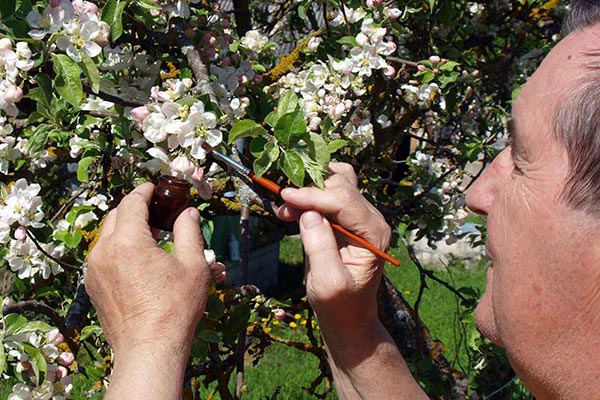
Figure 7. Apples can be hand pollinated, but doing so is a time-consuming and expensive practice.
Insider insights
Leo Sharashkin, beekeeper
Leo Sharashkin has more than 45 beehives, and yet he has never bought a single swarm of bees. He does not treat for varroa mites or other maladies, and yet the annual survival of his colonies is 85 percent, far exceeding the 50–60 percent survival rate that is more common across the U.S. What’s his secret? Sharashkin is a bee trapper. Although honey bees are not native to Missouri or the U.S., they have been around long enough to establish wild, or feral, populations, which Sharashkin describes as “beautiful and robust.”
Each spring, these honey bees reproduce via swarming: The queen and about 40 percent of the colony’s bees leave the hive to seek a new home. Sharashkin says that by understanding what the bees are looking for in a home, you can set out bait boxes to trap them.
These feral bees are more resilient than domesticated bees because they have undergone many generations of natural selection in the wild.
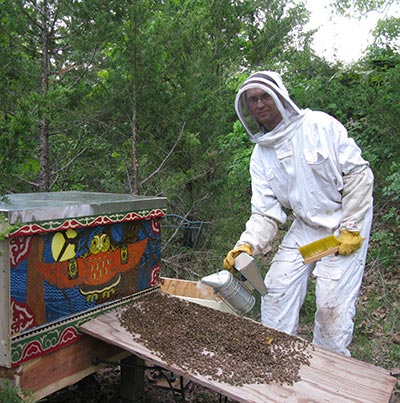
Leo Sharashkin. (Photo courtesy of Horizontal Hive)
According to Sharashkin, the greatest problem for Missouri beekeeping is that beekeepers predominantly are not using locally adapted stocks. He says, “Most bee packages people use to start hives come from southern states. Or they may even get their bees from a local beekeeper, but that beekeeper buys queens from Hawaii or other tropical locations. Bees vary greatly depending on what climate they are from. Bees from southern Florida will not do as well in upstate Michigan.
“All in all, this is the greatest challenge and leads to several problems: first, when you get bees from someplace else that are not adapted, you need to treat them because they will not survive parasites and other diseases without treatment and will not be matched to our climate. It is very challenging to keep bees organically/treatment-free if you are not using the local stock.
“But the more severe problem is that you cannot fully control the mating of bees. All the imported bees will interbreed with local bees. This dilutes the genetics of the local population, destroying their adaptability to the local conditions. The next generation is no longer as viable and as resilient as the local honey bees were. The bottom line is: The best thing we could do in this state to conserve our honey bees does not have to do with hive design or management methods or pesticides (even though these are important issues), but is instead to rely completely on our local, feral bees.”
Sharashkin received his doctorate in agroforestry from the University of Missouri. He has given over 300 presentations on four continents about sustainable beekeeping and gardening, and is the editor of the book Keeping Bees with a Smile. He currently lives in the Ozarks with his family. Visit the Horizontal Hive website for more information.
Jason Jenkins, monarch champion
Jason Jenkins was Missouri’s first monarch and pollinator coordinator. He helped coordinate the efforts of many different organizations, from Monsanto to the U.S. Fish and Wildlife Service, in pursuit of more effective conservation efforts. Jenkins said that the position is unique because it represents so many diverse organizations, and he is impressed by the enthusiasm for cooperation among organizations with ostensibly conflicting agendas:
“It’s not very often that you are going to see the Sierra Club and the Farm Bureau sitting at the same table advocating for the same thing. But we have that kind of culture here in Missouri. When something like pollinator conservation comes along, it doesn’t matter what logo you might wear on your shirt, we’re here to solve a problem, and it’s going to take all of us to solve the problem. So, check your logo at the door, and let’s work towards our common goal. That cooperation is something we are really good at here in Missouri.”
However, he has noticed shortcomings: “A lot of times, conversations are being had about the conservation of pollinators and how it will be done. There is talk about farmers and what agriculture should be doing, but when you look around the room, none of those farmers are there. The people who control the most acres and can make the biggest impact aren’t at the table when scientists and biologists are making decisions. We have a great relationship with our agriculture community in Missouri, but there is opportunity for more involvement.”
Jenkins explained that monarch populations have declined by up to 90 percent over the past few decades. These declines, he says, are not limited to monarchs but are felt by many other species as well. He says the greatest threat is the lack of quality habitat. “First, if there is no milkweed, there are no monarchs, because there is no place for the female to lay her eggs. But more importantly, we need nectar-producing plants that bloom spring through fall. This is important to provide monarchs with adequate forage during their spring and fall migrations. If they don’t have the fuel to get to and from Mexico, they can’t make it. The more flowering plants, the better. A higher-quality and more diverse habitat can support more monarchs. And what is good for the monarch is good for other pollinators and wildlife as well.”
Jenkins encourages everyone to get involved. “From the biggest landowner in Missouri to someone in a two-bedroom apartment, everyone can get engaged,” he says. “It doesn’t have to be expensive or require tons of land or knowledge. It is doable by everyone. The biggest thing is to get a little education. Learn more about pollinators and their plants. You can create a beautiful garden full of annuals and perennials that blooms for three seasons that benefits all insects. Even half a dozen milkweed plants in a pot will help the monarchs. It doesn’t take that much to make a difference.”
Jenkins received his bachelor’s degree in agricultural journalism from the University of Missouri and has more than 15 years of experience in public communication focusing on fisheries and wildlife management.

(Graph courtesy of Monarch Watch)
Elizabeth Graznak, organic farmer
Elizabeth Graznak is a small-scale organic farmer. She runs a community-supported agriculture (CSA) operation for 60 families, vends year-round at the farmers market in Columbia, and sells to restaurants, grocery stores, and florists across mid-Missouri. Graznak originally became interested in sustainable farming for environmental reasons, but she also loves being able to provide good, healthy food for her family and community.
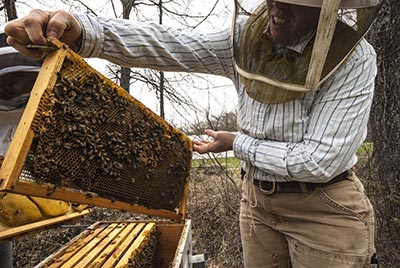
Elizabeth Graznak. (Photo courtesy of Happy Hollow Farm)
When asked how one can get involved with pollinator conservation, Graznak enthusiastically said, “They get a beehive! Absolutely, everyone should get a beehive for their backyard. It’s not hard; even kids can do it and enjoy it, and they will learn a lot from it. My daughter, Sylvia, is 4 years old, and she loves being around the bees. There are the years with good honey flow also. Last year, our hives did so well that we were able to give out honey to all the CSA members and sell some at the market.”
Graznak uses integrated pest management to control pests that attack her crops. This means that she uses an array of tactics — crop rotation, physical barriers, companion planting, and organic sprays — to keep pests at a manageable level. She believes the same integrated approach is needed to combat the growing pest and disease problems of honey bees. “If you want to have healthy bees, you have to manage for that just like you would manage for Swiss chard,” she said, “I do not think there is one answer or cure-all. I think it must be a combination of approaches. Letting the strong survive and building from fitter stocks is a good strategy, but it must come alongside appropriate management: revising hives, intervening with pest issues, relocating hives, using clean equipment, respecting the bees, etc. The people that are doing that are going to be successful.”
Graznak knows that a big portion of her cash crops — squash, melons, cucumbers, tomatoes — comes from the work of pollinators. For that reason, she plants flowering forb mixtures around her field edges and sows clover and other cover crops to provide forage for honey bees and native bees alike. She encourages people to think about where their food is coming from and whether it supports the values they uphold — and, also, to be grateful for pollinators.
Graznak received her master’s degree in horticulture from Cornell University in Ithaca, New York. She is the proprietor of Happy Hollow Farm, a USDA-certified organic flower and vegetable farm located in central Missouri.
Conservation in action
Actors in pollinator conservation
There are many campaigns to save the bees, monarchs and other pollinators. They work to preserve the resources and conditions that will allow these creatures to grow and reproduce. For pollinators, these resources and conditions are adequate foraging and nesting resources that are free of chemical toxins. Their availability will allow robust populations to adapt to the future environmental challenges of climate change, urbanization and new diseases.
Pollinator conservation depends largely on the decisions and land use practices of private landowners. Over 90 percent of the land in Missouri and 70 percent of the land in the U.S. is in their hands. From the local to the international level, numerous organizations and agencies collaborate with landowners on pollinator projects. Understanding these groups’ roles can increase your effectiveness with conservation measures.
Several international organizations of note are involved in pollinator conservation. The North American Pollinator Protection Campaign (NAPPC) consists of 160 partner groups that encourage resident and migratory pollinator health via education and outreach, collaborative partnerships, and science-based policy decisions. It is the primary international organization that works for the protection of monarch butterflies in North America. The International Union for Conservation of Nature (IUCN) and the Convention on Biological Diversity are the leading organizations that inform international policy at the global scale and monitor the conservation statuses of species. In 2016, the rusty patched bumble bee (Bombus affinis) was put on IUCN’s red list as a critically endangered species.
In 2016, the U.S. government published a science-based Pollinator Research Action Plan with these three goals:
- Reducing annual honey bee losses to less than 15 percent over the next 10 years
- Increasing monarch populations to at least 225 million at wintering grounds in Mexico by 2020
- Restoring or enhancing 7 million acres of pollinator habitat across the country via public–private landholder relationships
In Missouri, many active organizations and partners assist in pollinator conservation. One of these is the a statewide chapter of the Xerces Society, an invertebrate-focused conservation group. This organization provides guides on native bees and their host plants, sponsors outreach events, and partners with other organizations to implement conservation practices. The Missouri Department of Conservation (MDC) manages nearly 1 million acres of land across the state and works in a variety of Missouri ecosystems to monitor and maintain biodiversity. MDC also conducts outreach education programs that promote pollinator awareness and environmental stewardship. MU Extension, in addition to conducting educational programming, provides opportunities for volunteers to become involved with pollinator conservation in their communities through the Missouri Master Gardener, Master Pollinator Steward and Master Naturalist programs (the latter of which is conducted jointly with MDC).
Missouri landowners are also provided with financial incentives through partnerships with the U.S. Department of Agriculture (USDA) and National Resource Conservation Service (NRCS). If farmers opt to plant pollinator forage rather than commodity crops, they can earn sign-up bonuses, project cost-shares, and annual payments through the USDA’s Conservation Reserve Program (CRP). They must enroll for at least 10 years and plant mixes of native grasses and wildflowers. Likewise, through NRCS’s Conservation Stewardship Program (CSP) and Environmental Quality Incentives Program (EQIP), landowners can earn incentives and cost-shares by planting habitats for pollinators. The U.S. Fish and Wildlife Service and MDC recently partnered with these organizations to make monarch butterfly habitat restoration projects more viable for property owners.
With Missouri right in the middle of the monarch butterfly migratory highway, the state has many organizations geared to create or enhance monarch habitat to aid in their migration. The citizen-science-based collaborative Missourians for Monarchs developed the first state-level conservation plan focused on the monarch butterfly. The group aims to plant roughly 20,000 acres of pollinator habitat each year for the next 20 years. MU Extension is also planting milkweed and other native wildflowers on many of its properties across the state, creating waypoints for monarchs as they pass through. Although the focus is on monarchs, many pollinators benefit from these wildflower plantings.
Several other organizations in Missouri have pollinator-focused conservation programs. The St. Louis Zoo’s Center for Native Pollinator Conservation collaborates with the Missouri Department of Transportation to develop pollinator rights-of-way, leads outreach programs, and helps conduct the Bumblebee Specialist Group with IUCN. The Missouri Botanical Garden leads the collaborative effort Project Pollinator in St. Louis to promote pollinator awareness and create habitat. Numerous beekeeping groups, including the Missouri State Beekeepers Association, lead theory- and practice-based courses for beginning and experienced beekeepers alike. Grow Native, a plant marketing and education organization founded by the Missouri Prairie Foundation, helps protect and restore biodiversity by increasing conservation awareness of native plants and their effective use in various landscapes.
One of the greatest successes in pollinator preservation efforts in Missouri is the partnership these organizations formed in 2016 through the new position of monarch and pollinator coordinator, funded by the nonprofit organizations Pheasants Forever and Quail Forever. This position was created to unite over 30 different interested groups in working towards common goals. These efforts and partnerships make Missouri one of the most forward-thinking states in the pollinator conservation movement.
Landowner assistance for benefitting pollinators
Federal
The U.S. Department of Agriculture (USDA) provides guidance and financial assistance to landowners participating in certain conservation programs through the National Resource Conservation Service (NRCS) and the Farm Service Agency (FSA).
In March 2017, NRCS introduced a new conservation practice standard (CPS) to benefit pollinators. CPS 643 centers on providing food, shelter and nesting resources for native pollinator species. See the conservation practice standard 643 fact sheets in the resources section for information on managing habitats for native pollinators.
FSA oversees a conservation reserve program (CRP) with an initiative that specifically addresses pollinator habitat, CP-42. For information on this initiative, see the CRP fact sheet in the resources section and inquire at your county’s FSA office.
Additionally, the U.S. Fish and Wildlife Service’s Partners for Fish and Wildlife Program can provide technical assistance and potential savings through equipment and materials sharing.
State
The Missouri Department of Conservation (MDC) administrates a Landowner Assistance Program (LAP) that can provide up to 75 percent cost-share for suitable habitat establishment, as well as some additional options.
A Habitat Challenge Grant (HCG) program may apply in some situations, as may some MDC cost-share programs for wildlife in general, which could also benefit pollinators.
Opportunities for improved conservation
Agriculture offers many opportunities for improved pollinator conservation practices. For example, most milkweed in Missouri is found in and around farms. Given that nearly half of Missouri’s land is in agricultural use, small improvements on farms could significantly benefit pollinator habitat. Research revealed that small, diversified farms usually have a richer community of pollinators and receive better pollination services than farms with more uniform broad-scale plantings. Although large commodity farms often cannot realistically diversify their croplands, they can implement practices, such as the following, that provide improvements for pollinators and other wildlife:
- Rotate crops as part of an IPM strategy that will help mitigate pests, decreasing the necessity for pesticides.
- Plant marginal lands along fences and around ponds with native wildflowers and perennials. Many seeds — such as clover, coneflower and aster — do well broadcasted over bare soil in fall or winter.
- Practice prescribed burning between October and February to help control exotic plants, promote vegetative regrowth, and provide bare soil for ground-nesting bees (Figure 8).
- Leave land fallow or plant it in cover crop between plantings to boost soil fertility and provide pollinators with foraging resources.
- Plant buffer zones along crop edges, between properties and along bodies of water if you intend to use pesticides. This practice will help reduce unwanted drift.
- Designate no-till zones to minimize disturbance of ground-nesting bees and destruction of their nests. This practice also creates a more biodiverse soil, which can provide more fertility and pest control.
- Leave weeds around the farm. Many of the plants we consider weeds, such as dandelions and henbit, are actually great sources of forage for pollinators.
- Enroll in CRP, CSP or EQIP programs. Many of the above practices will qualify farmers and landowners to receive cost-sharing or other financial incentives through these programs.
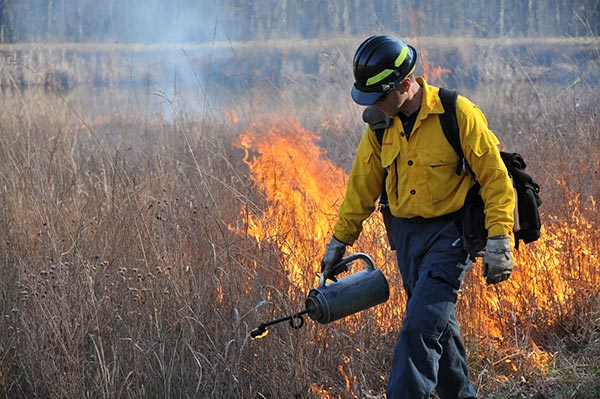
Figure 8. The practice of burning prairie reduces woody species and promotes the growth of native forbs and legumes.
Although Missouri’s major commodity crops — corn, soybean and wheat — do not require animals for pollination, incorporating these practices into a farming operation will allow farmers to reap improved pollination services in their gardens and orchards. Benefits also flow to the natural pollination networks, which will help maintain Missouri’s biodiversity and ecosystem health. Enhanced pollinator-friendly farming practices across the state are perhaps the greatest opportunity for improved pollinator conservation.
Make a difference for pollinators with your farm or rural property
Because most Missouri land is in private ownership, landowners have the power to make a difference for pollinators. Much of Missouri’s privately held land is devoted to agriculture and is used for either row crop production, animal forage production in pastures and hay fields, or other unspecified activities. Through applying best management practices for pollinators on their land, farmers and other rural landholders can enhance habitat for pollinators. For guidance, consult the Missourians for Monarchs habitat initiative’s three-part Best Management Practices series:
- Row Crop Production
- Monarch Habitat (Grazing)
- Management Activities for Rural or Private Lands
Existing natural areas — including state parks, conservation areas, national forests, and even the urban forest or prairie patch — also represent opportunities for improving pollinator forage and habitat. Simple steps, such as introducing a greater variety of pollinator-friendly plants that flower throughout the season, will benefit pollinators. Be sure to consult or partner with MDC or NRCS before transporting seeds and introducing new species to an area. Enhancing existing natural areas is a great way to improve pollinator conservation.
In addition, any vacant or marginal land in towns and cityscapes is an opportunity for improved pollinator habitat. These spots includes swathes along sidewalks, community gardens, golf courses, road margins, utility easements, school or business campuses, urban spaces and the like. With a bit of organization and planning, these vacant spots can hold a diversity of wildflowers and perennials for pollinator forage and nesting. These plantings will not only provide a richer habitat for pollinators and other wildlife but will also create more pleasant and welcoming neighborhoods for residents.
Doing your part
One of the most exciting aspects of pollinator conservation is that there is a lot each of us can do to improve the status of pollinators. Indeed, with 93 percent of Missouri land in private ownership, it is up to us. Our decisions as consumers and actions as homeowners shape the landscapes around us, which in turn impact habitats for pollinators and other animals. Here are some ways to get involved.
Landscaping and gardening
Landscaping and gardening for pollinators and other wildlife is one of the best ways to engage in pollinator conservation. It can be done on any scale, from the suburban home to large acreages of forest and pasture. The guiding principles for pollinator conservation are to provide resources for foraging and habitat, to leave undisturbed areas for hibernation, and to eliminate the use of pesticides and other chemicals whenever possible.
Good planning is key to success. Think about the space you have to work with, including vertical space for climbing plants. Make efficient use of space by layering levels of the canopy with different flowering trees, shrubs and herbaceous plants. Plant mixes that offer different sizes, shapes and colors of flowers that bloom at the same time, as well as flowers that bloom spring through fall. Try to ensure ground habitat and hibernation spaces are available for bees away from paths and foot traffic. Also, keep the area as free of agrochemicals as possible. Considering these tips when planning your project will help you to cultivate a more valuable space for pollinators.
Once thought to stifle biodiversity, urban and suburban areas are now seen to have the potential to host a variety of pollinators. Diverse floral and nesting plantings across yards, parks and schools can create a mix of resources for pollinators and other wildlife (Figure 9). Such areas contribute not only to local diversity but also to the diversity of the monarch flyway, along which monarch butterflies make their way to and from Mexico each year. Further, the pollinators themselves and the seeds and fruits that result from their labor provide primary nourishment for many migratory birds and other animals. A diverse and pesticide-free planting regimen can bring a more robust and diverse pollinator community to your property. If you plant it, they will come.
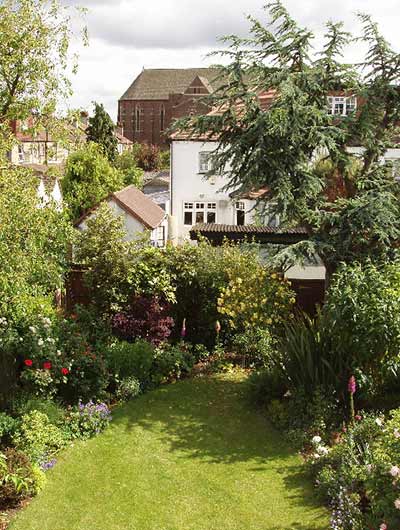
Figure 9. A vertically layered garden can provide quality resources for pollinators, with a mix of floral sources and habitat from lawns to bushes to trees.
Annuals
The efforts to create stunning flower displays with annuals has largely overlooked their potential benefit to pollinators. Some popular annuals often used in such displays are the shade-loving impatiens and the full-sun-desiring petunias. Neither provides much to pollinators; in the case of petunias, nectar productivity was bred out.
Many annuals still naturally provide resources to benefit pollinators, but some do not. Because of the public’s renewed interest in pollinators, however, flower breeders are trying to restore pollen and floral resources to some new introductions. As these come onto the market, the plant tags and promotional point-of-purchase advertising will help educate consumers about which plants are pollinator-friendly. Meanwhile, Table 1 lists prospects to include in your garden, landscape or planters. For a more comprehensive list, see the Cincinnati Zoo’s lists of best plants for pollinators.
Table 1. Some common annual flowers that benefit pollinators.
| Common name | Scientific name |
|---|---|
| Sweet alyssum | Labularia maritima |
| Bachelor’s button, or cornflower | Centaurea cyanus |
| Cosmos* | Cosmos bipinnatus |
| Flowering tobacco | Nicotiana alata |
| Lantana | Lantana camara |
| Marigold* | Tagetes spp. |
| Portulaca, such as moss rose* | Portulaca spp. |
| Spider flower | Cleome hassleriana |
| Sunflowers* | Helianthus annuus |
| Zinnias | Zinnia spp. |
| *Use single blooming types; avoid doubles. | |
Perennials
The opportunity to add habitat and floral resources for pollinators is likely the greatest with herbaceous ornamental perennials. Selecting and organizing plants for a butterfly garden is a bit more complicated. For maximum benefit, it needs to contain food plants for the caterpillars and nectar plants for the butterflies or moths.
Many resources are available to help gardeners — from novice to experienced and ambitious — select plants to attract pollinators. One such resource is the Grow Native program, which provides numerous sample garden plans that include specific plant recommendations. Native plants have proven to be successful at attracting and sustaining pollinators.
A pollinator garden will generally do best in a location that receives full sun, which means it receives at least about eight hours of direct sunlight a day. Before planting a garden, you will need to determine how to lay it out, whether to start from seeds or with plants, and what care it will need once established. The site and any plans you work from will require detailed consideration, but here are a few simple concepts to keep in mind:
- Choose a variety of flower colors to attract diverse pollinators.
- Select plants to provide floral resources all season long.
- Plant in groups or drifts to make the flowers easily visible to pollinators.
- Group plants of the same species rather than scattering them throughout.
Don't forget the herbs
Whether annual or perennial, many herbs serve pollinators well. Here are 10 that are easy to grow: basil, borage, chives, cilantro, dill, fennel, lavender, mint, oregano and sage.
Table 2 presents examples of perennials that are widely recognized as being excellent for pollinators. Much research has been, and continues to be, done to identify the best perennials for pollinators, so such plant lists change over time and no one list is definitive. There are many appropriate plants to choose from, each with its own pros and cons (for example, one may be a wonderful pollinator plant, but also be unattractive and thorny). Some key points have emerged from the research:
- There can be year-to-year variation, so data should be collected over several years.
- Total pollinator visits is generally considered the most important result, but it needs to be balanced by the diversity of pollinators attracted. For example, a given plant may be highly attractive to honey bees but not to many other pollinators.
- Named cultivars or selections are generally somewhat less attractive than a mix of that same species, but the difference is not significant or consistent enough to cause great concern. If you like a particular plant and it’s good for pollinators, use it.
Table 2. Alphabetical list by genus of select perennials recognized for attracting pollinators in the Midwest and South Central U.S.
| Genus | Well-regarded species | Common generic name | Common specific name |
|---|---|---|---|
| Agastache | A. foeniculum, A. nepetoides | Hyssop | Anise, yellow giant |
| Asclepias | A. incarnata, A. purpuracens, A. syriaca, A. tuberosa | Milkweed | Swamp, purple, common, butterfly |
| Baptisia | B. australis, B. bracteata | Indigo | Blue false, wild cream |
| Coreopsis | C. lanceolate, C. tripteris, C. verticillata | Tickseed | Lanceleaf, tall, Zagreb |
| Dalea | D. candida, D. foliosa, D. purpurea | Prairie clover | White, leafy, purple |
| Echinacea | E. pallida, E. paradoxa, E. purpurea | Coneflower | pale purple, yellow, and purple |
| Eryngium | E. yuccifolium | Rattlesnake master | |
| Eupatorium | E. coelestinum, E. hyssopifolium, E. perfoliatum | Wild ageratum, thoroughwort, bonset | |
| Eutrochium | E. dubium, E. fistulosum | Joe Pye weed | Coastal plain, spotted |
| Geranium | G. wallichianum x himalayense, G. maculatum, G. x cantabrigiense | Geranium | Azure Rush, wild, Biokovo |
| Helianthus | H. divaricatus, H. multiflorus | Sunflower | Woodland, many-flowered |
| Liatris | L. microcephala, L. pycnostachya, L. scariosa | Blazing star | Dwarf, prairie, eastern |
| Lobelia | L. cardinalis, L. siphilitica | Cardinal flower | Red, blue |
| Monarda | M. fistulosa, M. punctata | Wild bergamot, bee balm | |
| Penstemon | P. digitalis | Beardtongue | Tall white, Dark Towers |
| Phlox | P. maculata x glaberrima, P. paniculata | Phlox | Minnie Pearl, garden |
| Pycnanthemum | P. muticum, P. tenuifolium | Mountain mint | Clustered, narrowleaf |
| Solidago | S. drummondii, S. nemoralis, S. rigida, S. speciosa | Goldenrod | Cliff, gray, stiff, showy |
| Symphyotrichum | S. laeve, S. novae-angliae, S. oblongifolium | Aster | Blue, New England, aromatic |
| Veronicastrum | V. virginicum | Culver’s root |
Trees and shrubs
Trees and shrubs that benefit pollinators
This list of some common trees and shrubs that benefit pollinators may give you an appreciation for ones you might already have in your yard or nearby.
- American beautyberry
- Black locust
- Dogwood
- Elderberry
- Hickory
- Honey locust
- Maple
- Pawpaw
- Pecan
- Persimmon
- Plum
- Pussytoes
- Sassafras
- Serviceberry
- Spirea
- Willow
- Witchhazel
A simple best management practice to aid pollinators is to provide pollen and nectar sources from early spring to late fall. To do this, include trees and shrubs in your plantings. Trees and shrubs are especially needed early in the season. Many gardeners and landowners already have pollinator-friendly woody plants, but likely don’t realize it and may be able to plant more. Table 3 identifies select trees and shrubs to consider planting for pollinators.
Be aware that plants with like names are not necessarily equal in attractiveness to pollinators. For example, consider the well-known Viburnum garden shrubs. The viburnums include a Burkwood hybrid, which is attractive to pollinators, and Koreanspice viburnum, which is not.
Hydrangea shrubs have become more popular because they tolerate shade and provide long-lasting color. However, most do not benefit pollinators, although some species, such as Hydrangea paniculata Grandiflora are moderately beneficial. If you have questions about plants and need objective and scientifically sound advice, try Missouri Botanical Garden’s online plant finder.
Table 3. Select top trees and shrubs for attracting pollinators in the Ohio Valley Region.
| Common name | Scientific name |
|---|---|
| Trees | |
| Cornelian cherry | Cornus mas |
| Flowering cherry | Prunus spp. |
| Flowering crabapple | Malus spp. |
| Red horsechestnut* | Aesculus x carnea |
| Eastern redbud* | Cercis canadensis |
| Golden raintree | Koelreuteria reticulata |
| Devil’s walking stick* | Aralia spinosa |
| Bee bee tree | Tetradium danielii |
| Winged sumac* | Rhus copallinum |
| Seven-son flower | Heptacodium miconioides |
| Common name | Scientific name |
|---|---|
| Shrubs | |
| Burkwood viburnum | Viburnum burkwoodii |
| Foster’s holly | Ilex x attenuata |
| Ninebark* | Physocarpus opulifolius |
| False Indigo* | Amorpha fruticosa |
| Buttonbush* | Cephalanthus occidentalis |
| Climbing rose* | Rosa setigera |
| Common winterberry* | Ilex verticillata |
| Bottlebrush buckeye* | Aesculus parviflora |
| St. John’s Wort* | Hypericum frondosum |
| Clethra* | Clethra alnifolia |
| *Native plant. Adapted from the University of Kentucky and Horticultural Research Institute handout Woody Ornamentals for Bee-Friendly Landscapes (Ohio Valley Region). |
|
Vegetables
For vegetables to benefit pollinators, they need to flower. However, many are harvested before they do (for example, cabbage, carrots, broccoli, beets, lettuce, onions and radishes). Several flowering vegetables benefit some pollinators but don’t require pollinators for flower fertilization (for example, green beans, sweet corn, tomatoes and peppers); pollinators generally improve their fertilization though.
The royalty of the veggie patch for pollinators is the plant family Cucurbitaceae, also known as the cucurbits. Members of this royal family include cucumbers, gourds, melons, squash and watermelons. Pollinators are required to successfully fertilize their flowers. Therefore, it shouldn’t be surprising that cucurbit flowers are highly attractive to many pollinators, especially bees. You are sure to benefit pollinators if you grow cucurbits. If you need to treat them with an insecticide, apply it in the evening.
Use buckwheat as a cover crop in your vegetable garden whenever possible. Bees love it. Cover crops can also be used in other applications (Figure 10).
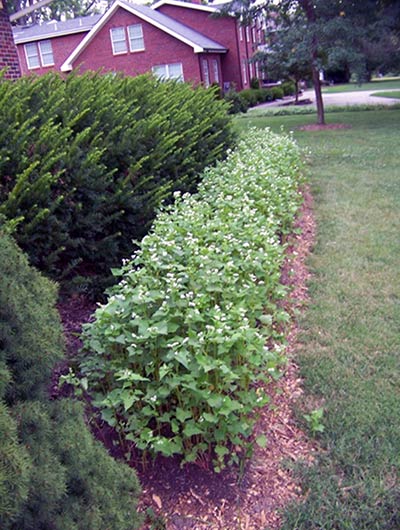
Figure 10. Although cover crops are generally identified with vegetable gardening, they can also be used in other applications, such as to condition the soil for a new planting bed.
Backyard habitat for monarchs
Size
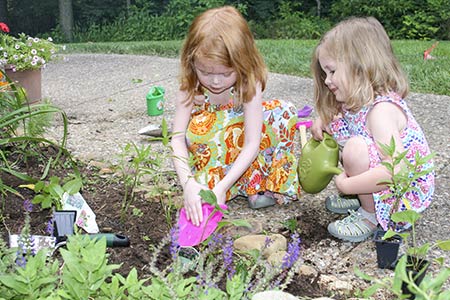
A suitable monarch habitat can be easily integrated with an existing flower garden. The minimum size of a milkweed planting is 9 square feet; however, a truly effective monarch habitat will be at least 100 square feet. The total area may be split among several sites at your location, and there is no upper limit for the size of a monarch habitat.
Exposure
Monarch-friendly plants need lots of sun; therefore, monarch habitats need to be located in an area that receives at least six hours of sun a day. Find shade tolerance of recommended plants on the Missouri Department of Conservation's (MDC) backyard habitat for monarch butterflies webpage.
Drainage and soil type
Milkweeds and nectar plants will do best in relatively light (low-clay) soils. Good drainage is needed to avoid root rot and provide good aeration of the roots. Areas with poor drainage may need more moisture-tolerant species such as swamp milkweed and New England aster.
Shelter
To ensure that the maximum number of monarchs survive in your habitat, the plants should be located relatively close together. However, they should not be crowded—be sure to follow the planting recommendations specific to each plant. All monarch life stages need shelter from predators and the elements. Planting milkweeds and nectar plants close together contributes to this shelter for monarchs and other wildlife.
Food
Milkweed plants. Monarch butterfly larvae only eat milkweed. Therefore, to maximize the use of your habitat by monarchs, include a number of milkweed species. It is best to have at least 10 plants, made up of two or more species; however, a large number of plants (more than 10) of one species is sufficient. Milkweeds of different species mature and flower at different times during the season. By increasing the number of milkweed species in your habitat, you will increase the likelihood that monarchs will use your property for a longer period during the breeding season.
Nectar plants. Monarchs, other butterflies, and numerous pollinators need nectar. When your monarch habitat provides nectar sources that bloom sequentially, it supplies nutrients throughout the breeding season and the migration in the fall. A monarch habitat should contain at least four biennial or perennial native plants that provide nectar for butterflies.
Native plant species recommended for Missouri
Visit MDC's monarch webpage for a list of recommended native wildflowers for monarchs along with planting diagrams. Plants, rather than seeds, are recommended in flower gardens to obtain the fastest results. Local sources for seeds and plants of these native species can be found on Grow Native's website. Learn about propagating milkweed plants in the Missouri Conservationist magazine article "Homegrown Milkweeds."
(Photo and text of this section courtesy of the Missouri Department of Conservation)
Eco-friendly lawns
Many homeowners cherish pristine lawns. Unfortunately, to maintain such lawns, they often use high concentrations of agrochemicals, with the unintended result of biodiversity dead zones. Lawns are constantly trying to revert to grassland or forest. By understanding this urge, we can better understand nature’s processes and create a space for more biodiversity. Plus, the so-called weeds that appear can tell us much about the health and condition of our soil. For example, dandelions are indicators of acidic, compacted soil, and they break up this soil with their deep taproots. Similarly, clovers are an indication of nitrogen-poor soils, which they help to improve through a fascinating, mutually beneficial relationship with root-dwelling rhizobia bacteria that convert atmospheric nitrogen to usable nitrogen in the soil. Dandelions, clovers and other nuisance weeds are important sources of forage for pollinators and are critical for lawn, soil and ecosystem health (Figure 11).
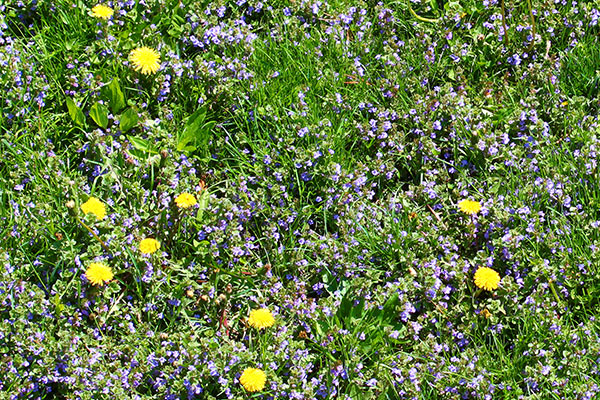
Figure 11. Letting part of your lawn go wild is an easy way to provide important forage sources for pollinators.
Thus, you could save money and time, and observe more pollinators by letting part of your lawn go wild. By letting nature take its course in your lawn, you will provide pollinators with much needed additional forage in suburban or urban areas. You will also become more attuned to the natural processes of your local ecosystem, and have a more biodiverse and exciting lawn, which could serve as a talking point to get others interested in pollinator conservation.
An alternative to letting part of your lawn go wild is to plant an eco-friendly lawn. Doing so is more possible now than it has been in the past due to the demand that has developed through home gardeners and professionals in parks, golf courses and other landscape niches. Although most seed sold for lawns is purely grass, several mixes are available. Local retailers may not carry them, but you can find sources online by searching on terms such as “eco-friendly lawn seed mixes,” “alternative lawns” or “eco-lawn.” Some of these seed products are only grass, which might provide benefits such as being drought tolerant or needing little or no mowing. Some prominently featured blends, however, include microclover. Other blends go beyond just clover and include a mix of low-profile flowers or flowers that tolerate occasional mowing, such as sweet alyssum, baby blue eyes and white yarrow — all which benefit pollinators. Be aware that dandelions will find their way into such a pollinator-friendly habitat. For best success in establishing an eco-friendly lawn, plant into freshly tilled soil in an area in which the previous vegetation has been killed or removed. Follow the specific recommendations of the seed mix. In Missouri, seeding in late summer or early spring would be preferred to ensure germination of clover and cool-season grasses. During the first summer, keep the new lawn watered during dry spells to ensure the perennial clover and grasses establish successfully.
A plant that reduces lawn fertilizer use
If you want to use less fertilizer to benefit pollinators, consider adding microclover to your lawn. Microclover (Trifolium repens L. var. Pirouette) is a selection from white clover (Trifolium repens) that has smaller leaves and a lower growth habit. Because it is shorter, more of its flowers are retained when mowed — flowers that provide pollen and nectar for pollinators.
When seeded at an appropriate rate, microclover mixes better with most turfgrass species than common white clover does. It does not form clumps or compete excessively with desirable turfgrasses. Because it fixes nitrogen in the soil, microclover reduces fertilizer use an estimated 1 to 2 pounds of nitrogen per 1,000 square feet a year.
Agroforesty practices for pollinator habitat
Agroforestry provides a unique opportunity to enhance nectar and pollen sources and nesting sites for crop-pollinating bees. Weed contromil should be concentrated to a narrow strip nearest the trees to leave as much undisturbed area as possible for flowering plants and nesting sites.
Riparian forest buffers are excellent locations to incorporate early flowering willows, as well as shrubs and forbs that require more water than is naturally available elsewhere. Riparian buffers are especially important for bees during hot summer months in areas where plants in upland areas dry out.
Windbreaks and hedgerows, by design, reduce wind velocity in adjacent fields. Windbreaks provide places to plant flowering trees and shrubs and other blooming perennials close to fields. Make a special effort to include flowering forbs on the margins of the windbreak or hedgerow. The area between the trees could also be used for beneficial forbs during the establishment period of the windbreak.
Silvopasture provides an open understory where a variety of flowering forbs, such as alfalfa or clover, can be over seeded. When combined with rotational grazing practices, these legumes will have an opportunity to flower before being eaten. Clusters of flowering shrubs could provide benefits for pollinators and other wildlife. Depending on the location, harvestable flowering trees, such as black cherry, black locust, or maple, can be included into a silvopasture system.
Alley cropping presents an opportunity to grow plants in close proximity that have complementary flowering periods. By paying careful attention to bloom periods and using multiple species, an alley cropping system can provide nearly continuous pollen and nectar forage within a single farmscape. Consider flowering trees such as black cherry or basswood along with the more typical alley cropping trees of walnut, pecan or oak. A legume forage crop between rows will not only fix nitrogen but also provide nectar and pollen for bees. Diverse native forbs and shrubs may be planted in rows for cut flowers, berry production, or the nursery market, as well as for pollinators.
Forest farming simultaneously manages both forest overstory and understory plants. Include insect-pollinated valuable crop trees, such as yellow (tulip) poplar, maple, basswood and black cherry, in the overstory to benefit pollinators. Some cultivated understory plants, such as ginseng, goldenseal and black cohosh, may also benefit from pollinators. For example, black cohosh generally relies on bumble bees for pollination, but it does not produce nectar to attract the bees. It must rely on nearby prolific nectar producers, such as pale touch-me-not or whiteflower leafcup, to attract the bees. The pollination of these different forest understory plants is not well understood, but pollinators should be encouraged.
Other sites — such as existing natural habitat, field and road edges, drainage ditches, land around buildings, and fields that are too wet or too dry for crop production — also provide convenient, under-used places to cultivate bee forage.
Citizen science
The practice of science is not reserved only for individuals with lab coats and advanced degrees. Nor is it as complex or hard to grasp as you might think. You can get involved. Simply knowing when a flower is in bloom or when migrant birds arrive in an area helps scientists understand how nature changes over time. When such information is compiled across the state, country or planet, it can create a wonderfully representative snapshot of biological change and ecosystem processes. Indeed, because of today’s increased access to information and ability to share it, citizens are becoming irreplaceable in science. From climate change to bird-watching, and everything in between, ordinary people around the world are compiling data that is used to help understand current issues, inform policy, and enact conservation.
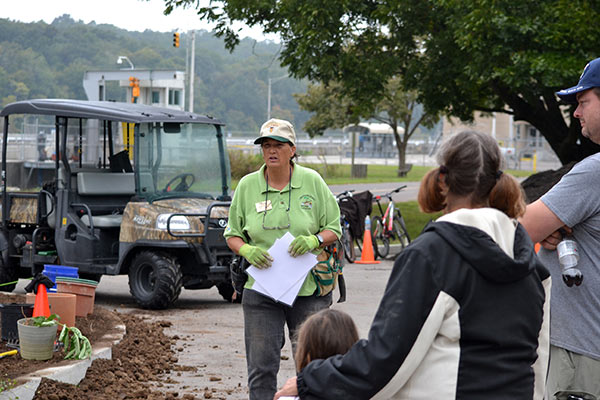
Figure 12. Citizen science projects include planting pollinator gardens in public spaces.
Citizen scientists have many opportunities to engage in pollinator research at local and national levels (Figure 12). Some popular options are described below (see Resources for links to their sites).
- Bumblebee Watch is a collaborative for tracking and conserving North American bumble bees. Users can learn about bumble bee ecology and identification, stay up-to-date on conservation statuses, map sightings, upload photos and create virtual collections, and communicate with other citizen scientists.
- The Great Sunflower Project maps the pollinators and pollination services across North America. The website provides information about pollinator diversity and ecology, and offers interactive maps and historical data. People are encouraged to record sightings from such places as their homes, schools, gardens and favorite trails. When compiled, this data helps us better see the pollinator status in North America.
- BeeSpotter is like Bumblebee Watch and the Great Sunflower Project, except it is specific to the Midwest. This project originated at the University of Illinois and focuses on the pollinators of Missouri, Illinois, Indiana and Ohio. On the website, you can learn about bees, submit findings, explore maps and data, and stay up-to-date on pollinator-related events and opportunities in the Midwest.
- The e-Butterfly website is filled with butterfly dynamic range maps, historical data, checklists and galleries. Here, you can upload and organize your butterfly photos, share observations with other enthusiasts from across the country and Canada, and contribute towards science and conservation. This website is one of the largest and richest data sources for butterfly distribution and abundance in the United States and is praised by science professionals.
- Journey North, Monarch Watch and Monarch Larva Monitoring Project are citizen scientist projects focused entirely on the monarch butterfly. You can submit your sightings, explore migration maps, buy rearing kits and milkweed, share with others, and get information on the latest reports and events. Check out these projects so you will be ready for the next monarch migration.
Citizen science projects are crucial to fully understand and reduce the declines in pollinators and pollination services across the U.S. Most important is for citizen scientists to provide accurate and honest reports. Key to these reports is the proper identification of pollinators. Differences in pollinators, especially bees, can be very subtle, which can make identification a real challenge — even for the expert. If you are unsure, snap some photos to share with others or refer to later with a guidebook. You can improve your identification skills through publications, courses, observation, photography, and websites such as those listed above, and by connecting with pollinator-savvy interest groups or individuals. Join the effort to learn about and conserve our pollinators by getting involved in citizen science.
Conclusion
Pollinators are vital for the health of both managed and natural landscapes. Without them, there would be fewer food plants for humans and a decline in biodiversity across most land-based ecosystems. They face many threats via habitat loss, disease, pests and chemicals. Given the trend of early the 2000s, the U.S. will likely lose many species of pollinators before the end of the century.
However, public awareness of the plight of bees and butterflies has increased. Popular again, they are more present than ever in art, culture, product marketing, policy, and scientific research. There is great momentum in Missouri and worldwide to understand pollinator declines and implement conservation practices. Pollinator conservation affects everyone and requires collaboration from all — the poet, farmer, scientist and consumer alike — to be wholly effective.
Conservation efforts for pollinators will benefit other wildlife, as the food web demonstrates. An obvious example is with birds, for which caterpillars are an important food source. Habitat created to benefit pollinators, including butterflies and moths, will help provide birds with an important food source in nature. You can make a difference whether you have a small garden or large farm.
The importance of citizen science in shifting public perception and policy, cannot be overstated. Although the public’s appreciation of insects might be relatively recent, citizens can look to other conservation organizations and their activities for ideas and motivation. The Audubon Society is widely known and recognized for how it has protected birds, but its activities have also benefitted other wildlife with the conserved habitat. A citizen science success story is the society’s annual Christmas bird count, which not only energizes many, but also provides information that affects public policy. It is exciting to see similar opportunities now available for pollinators. A key role of a Master Pollinator Steward is to consider ways to engage and help bring the pollinators back.
Recommended reading
The Forgotten Pollinators by S.L. Buchmann and G.P. Nathan (1997, Island Press, Washington D.C.) is perhaps the book that made the public aware of pollinator decline, and was published nearly a decade before colony collapse disorder was identified. This book is a well-written introduction to the role of pollinators in ecosystems and a call to arms for conservation and habitat restoration.
Natural Beekeeping: Organic Approaches to Modern Apiculture by R. Conrad (2013, Chelsea Green Publishing, Vermont) is a great book for the beekeeper interested in natural management practices. It is well-written and easy to read, and applying its practices will leave you with stronger, healthier hives.
The Bees in Your Backyard: A Guide to North America’s Bees by J.S. Wilson and O.J. Messinger Carrill (2016, Princeton University Press, New Jersey) is perhaps the most useful modern guidebook for bee enthusiasts. It is full of wonderful photos, helpful identification guides, native planting charts, and life history characteristics of all the major bee families in North America.
Attracting Native Pollinators: Protecting North America’s Bees and Butterflies by Xerces Society (2011, Storey Publishing, Massachusetts) is a fantastic book about creating pollinator habitat in your yard or on your property. It has helpful guides for native plants by region and a bee identification guide.
Pollinator Conservation Handbook by Xerces Society (2003, Xerces Society Publishing, Oregon) is a great introduction to all issues relating to pollinator conservation in the U.S. It includes an expansive reading list, native plant guides, and activities for educators.
Resources
Cincinnati Zoo’s lists of best plants for pollinators
Conservation practice standard 643 fact sheets
Conservation Reserve Program fact sheet
Grow Native landscape plans (link updated 7/30/20)
Missouri Botanical Garden plant finder
Missouri Department of Conservation
Monarch Larva Monitoring Project
National Resource Conservation Service
University of Missouri Center for Agroforestry
University of Missouri Extension publications
- G9500, Improving Habitats for Wildlife in Your Backyard and Neighborhood
- MP927, Assessing Wildlife Habitats and Natural Resources in Neighborhoods and Urban Environments: A Planning Guide for Wildlife Habitats in Urban Areas
U.S. Fish and Wildlife Service
Text credits
The text of the agroforestry practices section was adapted from the U.S. Department of Agriculture, National Agroforestry Center’s Agroforestry Note 33, Improving Forage for Native Bee Crop Pollinators.
Figure credits
- Achillea and Amada44, Wikimedia Commons, GNU General Public License
- Vecton, Shutterstock.com
- Collage of several stock photos
- U.S. Department of Agriculture, Agriculture Research Service
- U.S. Department of Agriculture, Agriculture Research Service
- U.S. Geological Survey
- Grandpa, Shutterstock.com
- U.S. Department of Energy
- David Hawgood, Geograph Project Limited, CC BY-SA 2.0
- Jim Quinn, University of Missouri Extension
- Wirepec, Bigstock.com
- Park Ranger Sarah Peace, U.S. Army Corps of Engineers